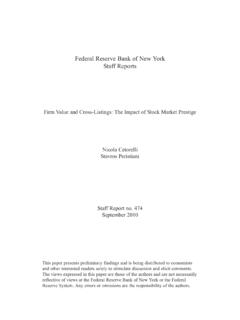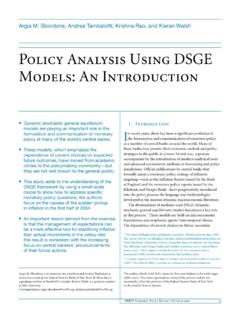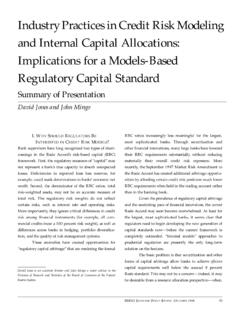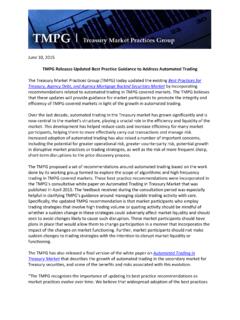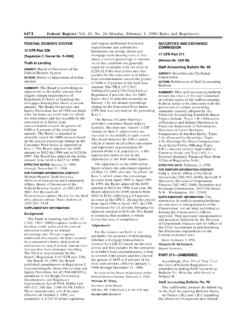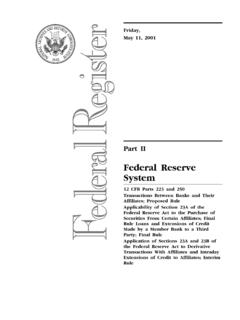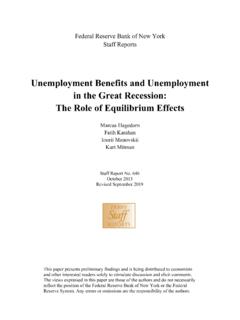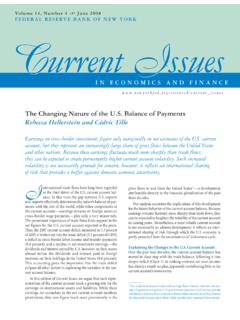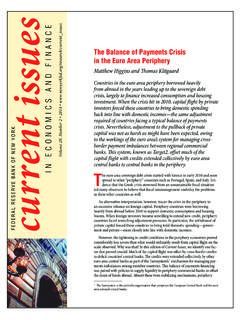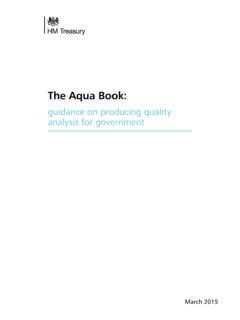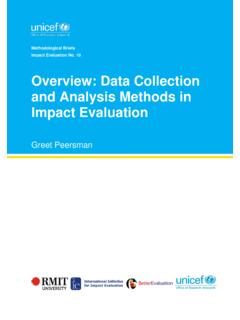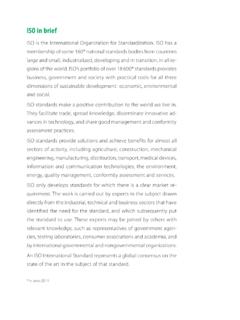Transcription of The Evolution of Banks and Financial Intermediation ...
1 Nicola Cetorelli, Benjamin H. Mandel, and Lindsay Mollineaux The Evolution of Banks and Financial Intermediation : Framing the analysis 1. Introduction Intermediation failure that did not necessarily, or at least not directly, result from bank failures. To be sure, many Banks did W hile the term the Great Recession has been loosely applied to almost every economic downturn in the past twenty years, the crisis of 2007-09 has more than most indeed fail during the crisis and many more were left with impaired operations outcomes that certainly exacerbated the scale and scope of the crisis. Nevertheless, major disruptions recessions lived up to that The crisis has been felt occurred among segments of Financial Intermediation activity across virtually all economic sectors and in all parts of the that had in recent years been growing rapidly and that did not world.
2 Still, if its effects have been widespread, its origins were seem to revolve around the activity and operations of Banks . narrower: the crisis had its roots in the Financial sector and For instance, we have learned that the crisis originated as manifested itself first through disruptions in the system of a run on the liabilities of issuers of asset-backed commercial Financial Intermediation . paper (ABCP), a short-term funding instrument used to This story is in itself not new. Many economic crises in finance asset portfolios of long-term maturities (see, for history have been the result of Financial crises, and many example, Gorton [2008]; Covitz, Liang, and Suarez [2009].)
3 Financial crises in turn originated as failures of Financial Acharya, Schnabl, and Suarez [forthcoming]; and Kacperczyk intermediaries. And in every instance the reference has been to and Schnabl [2010]). In this sense, ABCP issuers (conduits). Banks , in their essential role as deposit-taking entities involved perform typical Financial Intermediation functions, but they primarily in the business of lending. Thus, Reinhart and Rogoff are not Banks . Certainly, in many instances Banks were the (2008) identify some thirty separate instances of banking crises driving force behind ABCP funding growth, sponsoring across many countries and at different points in time during conduit activity and providing the needed liquidity and credit the last 100 years.
4 Enhancements. But the main point is that ABCP financing Indeed, the terms bank and Financial intermediary have shifts a component of Financial Intermediation away from the normally been used interchangeably. However, what was new traditional location the bank 's own balance sheet. Similarly, in this last crisis is that we witnessed many instances of Financial and concurrently with the ABCP disruptions, Financial markets 1. The description of the 2007-09 crisis as the Great Recession is commonly also witnessed a bank -like run on investors that funded attributed to Paul Volcker, who used the term in a speech in April 2009 their balance sheet through repurchase agreement (repo).
5 ( transactions, another form of Financial Intermediation that ). For the application of this term to earlier recessions, see grew rapidly but did not take place on bank balance sheets . (Gorton 2008; Gorton and Metrick 2010). Additionally, in the Nicola Cetorelli is a research officer at the Federal Reserve bank of New York; The views expressed are those of the authors and do not necessarily reflect Benjamin H. Mandel and Lindsay Mollineaux are former assistant economists the position of the Federal Reserve bank of New York or the Federal at the bank . Reserve System. Correspondence: FRBNY Economic policy Review / July 2012 1.
6 The Credit Intermediation Chain Asset flows Step 1 Step 2 Step 3 Step 4 Step 5 Step 6 Step 7. Credit, maturity, Credit, maturity, Credit Credit, maturity, Credit Credit, maturity, Maturity and and liquidity and liquidity transformation and liquidity transformation and liquidity liquidity transformation transformation (blending) transformation (blending) transformation transformation Loan Loan ABS ABS ABS CDO ABS Wholesale origination warehousing issuance warehousing issuance Intermediation funding Loans Loans Loans ABS ABS ABS CDO ABCP $1 NAV. CP ABCP Repo ABCP, repo CP, repo ABCP, repo Funding flows Source: Pozsar et al.
7 (2010). Note: ABS is asset-backed security; CDO is collateralized debt obligation; CP is commercial paper; ABCP is asset-backed commercial paper;. NAV is net asset value. aftermath of Lehman Brothers' default, money market mutual As the authors explain, the backbone of the new system is the funds, yet another class of nonbank entities that serve as credit Intermediation chain. The exhibit above, from the Financial intermediaries, experienced a run on their liabilities, Pozsar et al. paper, depicts the multiple steps in the chain. an event that triggered in turn an even bigger run on ABCP Loans are originated, but with a funding approach that involves issuers (Acharya, Schnabl, and Suarez, forthcoming).
8 A precise sequence of steps, during which they are removed The crisis has therefore exposed significant instances from the balance sheet of the originator (warehousing), and of Financial Intermediation failure but also an apparent then packaged into securities (asset-backed-security [ABS]. disconnect between Financial Intermediation activity and issuance). This last step could expand into additional steps that Banks . A new narrative has emerged, describing inter- may involve warehousing of the asset-backed securities mediation as a decentralized rather than a bank -centered themselves and further repackaging into more complex system, one in which the matching of the supply of securities (for instance, collateralized debt obligations, or ABS.)
9 And demand for funds occurs along an extended credit CDO issuances). Intermediation chain, with specialized markets and nonbank This decentralization of activities opens up significant institutions playing a part along the way. opportunities for economies of specialization, in which This is the so-called shadow banking model of Financial nonbank firms emerge as organizations that have a narrower Intermediation , as described, for instance, in Pozsar et al. scope than Banks but perform an important function in (2010).2 The authors characterize the transition from a bank - finalizing securitization activity.
10 In this alternative model, centered to a decentralized model in this way: In essence, the traditional Banks may have a diminished role. Understanding shadow banking system decomposes the simple process of the extent to which this is the case is important in and of itself, deposit-funded, hold-to-maturity lending conducted by Banks but it also raises key normative questions. Namely, what are into a more complex, wholesale-funded, securitization-based the consequences of the new reality for the monitoring and lending process that involves a range of shadow Banks (p. 13). regulation of Financial Intermediation ?
